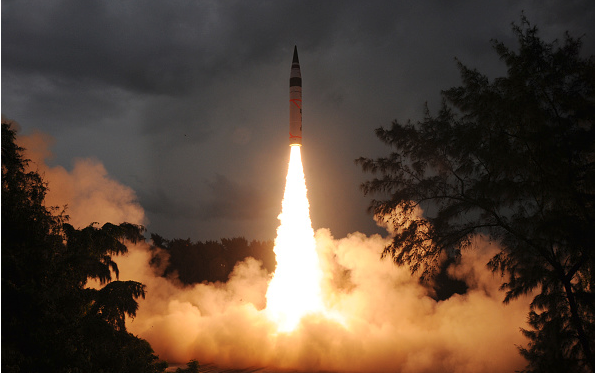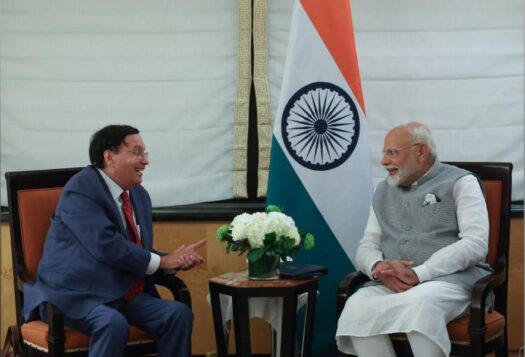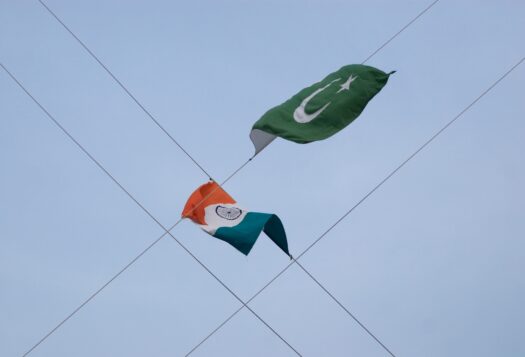
Deterrence theory suggests that a stable deterrence moderates the security dilemma between rival nuclear states. Nearly four decades ago, Kenneth Waltz, a leading nuclear optimist, advocated that the spread of nuclear weapons would guarantee peace and resolve complex security problems between countries. However, twenty years into their respective nuclear programs, India and Pakistan continue to perceive threats from each other—mistrust that has resulted in an intense nuclear arms build-up. With India’s ambition to become a global power and Pakistan’s continuing quest for security, nuclear deterrence remains unstable, and peace fragile, in South Asia. In order to promote peace in the foreseeable future, the two states require less rivalry and more understanding.
With India’s ambition to become a global power and Pakistan’s continuing quest for security, nuclear deterrence remains unstable, and peace fragile, in South Asia.
Rivalry is enduring due to divergent strategic directions, evolving competitive technologies, a growing power imbalance, the Kashmir conflict, and the transnational activities of non-state actors in the region. Recent events such as the terrorist attack on an Indian military base in Uri, claims of Indian surgical strikes on Pakistan, and Kulbhushan Yadav’s arrest in Baluchistan demonstrate the intolerant patterns of interaction between the two countries that threaten conflict escalation to the nuclear level. To generate harmony, India and Pakistan must allow themselves the ability to make strategic compromises and the flexibility to resume dialogue.
Revival of Lahore Declaration
A renewed political commitment can be made to normalize political relations by initiating a multipronged dialogue process. To this end, both countries should immediately seek the revival of the Lahore Declaration (1999). The Declaration seeks to resolve issues including Jammu and Kashmir, take confidence-building measures (CBMs) in the nuclear and conventional military fields forward, boost information technology cooperation, ease visa regulations, and promote trade.
Through the revival of this declaration, the two states may initiate these following steps (from highest to lowest levels of priority):
- Shared mechanism to address crossborder terrorism: This dialogue should take place between the highest level military and political leaderships of both the countries. It will be a difficult process, but through consistent interaction, dialogue, and substantive talks, the two states can reach out to a mechanism that focuses on irritants that would minimize probability of future crisis situation such as the attack on the Uri army base. In return, the two states can control crossborder attacks that result into the loss of life and further mistrust.
- Economic dialogue: The second step shall be to work on the integration of the two economies at a bilateral level. This process can take place between political leadership and business communities of the two states. The flow of cross-border trade can lead to increased interdependence that in turn would mitigate mistrust and promote shared economic prosperity.
- Revival of existing nuclear CBMs: Nuclear CBMs should be made more effective through civilized discourse between political-to-political and military-to-military leadership. Through open communication, the states should explore proactive measures to engage with people on both lines of the border to avoid misunderstandings and generate harmony. These include an additional security dialogue to mitigate the nuclear risks that new technologies continue to pose as well as joint seminars on understanding the consequences of nuclear weapons and their humanitarian and environmental effects.
- Kashmir issue: The complexity of the Kashmir issue requires that the two states deal with it at a later stage, after some dialogue has already occurred with a degree of success. Both states can build trust through talks to work on demilitarizing the Line of Control (LoC) and reducing the frequent ceasefire violations that are the source of constant discomfort for inhabitants on both sides of the divide. If this is successful, the two countries may endeavor to strike a compromise on the settlement of their bilateral disputes, keeping in mind the protection of human rights for Kashmiris.
An agreement to revive the Lahore Declaration, bearing in mind the above priorities, would minimize nuclear dangers by mitigating misperception between India and Pakistan. Moreover, this process will generate mutual economic dependence that in return can moderate patterns of routine political rhetoric like propaganda, hate speech, blame gaming, visa restrictions, and proxy wars.
Bilateral Nonproliferation Agreement
It is also pressing that India and Pakistan sign a comprehensive bilateral nonproliferation agreement in order to improve nuclear security and security. Political leadership of both countries should immediately initiate a dialogue towards such an agreement agreeing to: a) establish a bilateral moratorium on the non-testing of nuclear weapons; b) work together to slow down their fissile material production; c) initiate discussions for a bilateral agreement on a separation plan for all nuclear facilities, which would include opening up all civilian nuclear facilities to the International Atomic Energy Agency’s (IAEA) verification and full-scope safeguards; d) link the terms of this nonproliferation agreement to membership to the Nuclear Suppliers Group (NSG), which both India and Pakistan desire to achieve.
The decision to link the bilateral nonproliferation agreement to NSG membership provides a strong incentive for both India and Pakistan to abide by the terms of the agreement. As an added benefit, membership in the NSG may also allow the problem of India and Pakistan’s Non-Nuclear Non-Proliferation Treaty (NPT) signatory status to be addressed.

Unilateral Measures Towards Nuclear Transparency
India and Pakistan’s nuclear doctrines are deliberately ambiguous, perhaps because this helps countries achieve nuclear efficiency and sufficiency. Analysts have long noted that ambiguity, however, enhances the risks of miscalculation and can make deterrence unstable. Increasing transparency in nuclear doctrine, posture, and modernization plans will improve the chances of reaching deterrence stability.
Enhanced transparency in nuclear doctrine and posture would simultaneously further stabilize deterrence and build upon other improvements in bridging the trust deficit through dialogue.
To this end, both countries may publish their nuclear doctrines, reducing ambiguity wherever possible. For instance, India should clearly inform the world whether it embraces a policy of No First Use (NFU) or First Use, a policy of flexible response or massive retaliation. Similarly, Pakistan has adopted a policy of First Use due to its conventional inferiority, but it does not specify when and under what conditions it would employ tactical nuclear weapons (TNWs). It may be beneficial for Pakistan to declare its redlines in order to reduce the risks of accidental escalation during crises. Other transparency measures may involve the adopting and sharing of a list of targeting plans or even declaring the quantity of warheads in their arsenals. Enhanced transparency in nuclear doctrine and posture would simultaneously further stabilize deterrence and build upon other improvements in bridging the trust deficit through dialogue.
Strategic Dialogue for Nuclear Restraint
Both India and Pakistan would also benefit from pursuing a strategic dialogue between military leaderships towards policies of nuclear restraint. Strategic thinkers such as Vipin Narang have assessed that India’s No First Use nuclear doctrine has eroded and may be moving in the direction of a preemptive counterforce first strike. This shifting doctrine has generated immense anxiety within Pakistan. For example, there is clear understanding in Pakistan’s strategic community that India’s policy shift may increase demand for an increased number of warheads and delivery systems, with better accuracy and advanced early warning systems. If India fails to retain an NFU policy, it may push Pakistan in the direction of: a) the deployment of weapon systems at sea and land; b) heightened readiness of arsenals; c) increased number of warheads and their delivery mechanisms. In all likelihood, Pakistan’s expected reaction to India’s shifting nuclear doctrine would—while trying to avert nuclear conflict—lower the nuclear threshold and increase crisis instability. Thus, it is vital that India and Pakistan discuss what actions may be taken towards instituting policies of nuclear restraint, as this dialogue may open up opportunities to curb the ongoing arms race and reduce the risk of accidental nuclear war.
Editor’s Note: This piece is the first of a two-part series on the 20th anniversary of India and Pakistan’s 11 cumulative nuclear tests in May 1998. After 20 years, the situation on the subcontinent demands introspection: longstanding antagonism between India and Pakistan has been accompanied by the modernization of nuclear forces, evolving nuclear doctrines, the absence of bilateral dialogue, and a lack of impactful confidence-building measures. What concrete measures can New Delhi and Islamabad take to ameliorate the risks of a nuclear confrontation in South Asia? Read the other piece in the series here.
***
Image 1: MEAphotogallery via Flickr (cropped)
Image 2: Pallava Bagla via Getty


